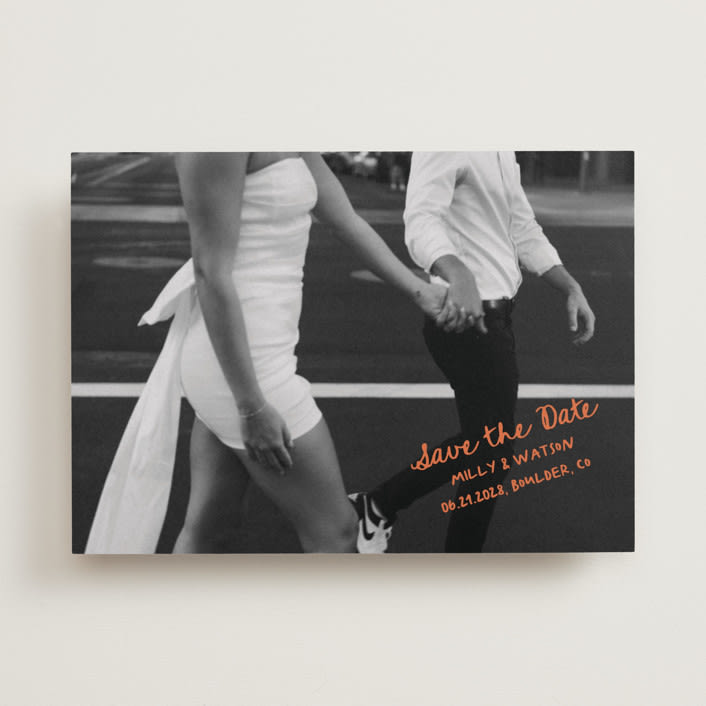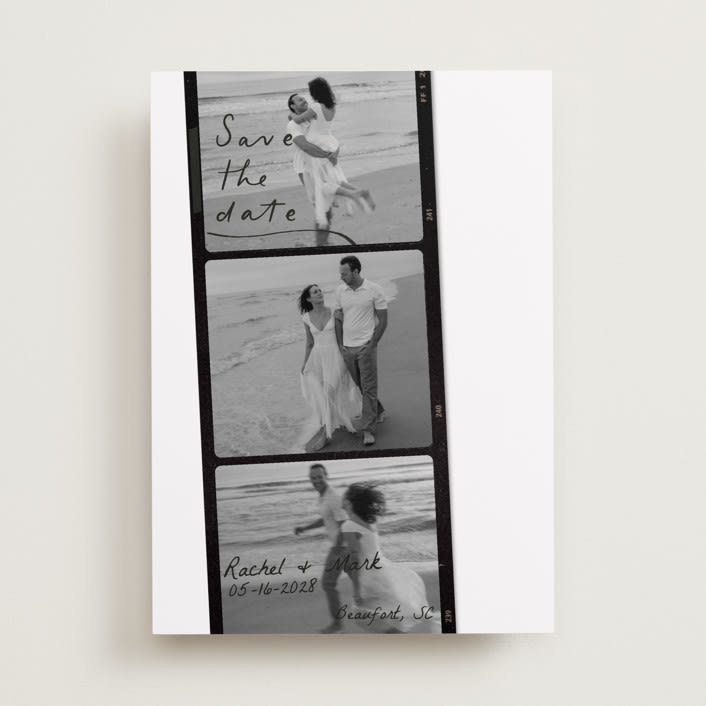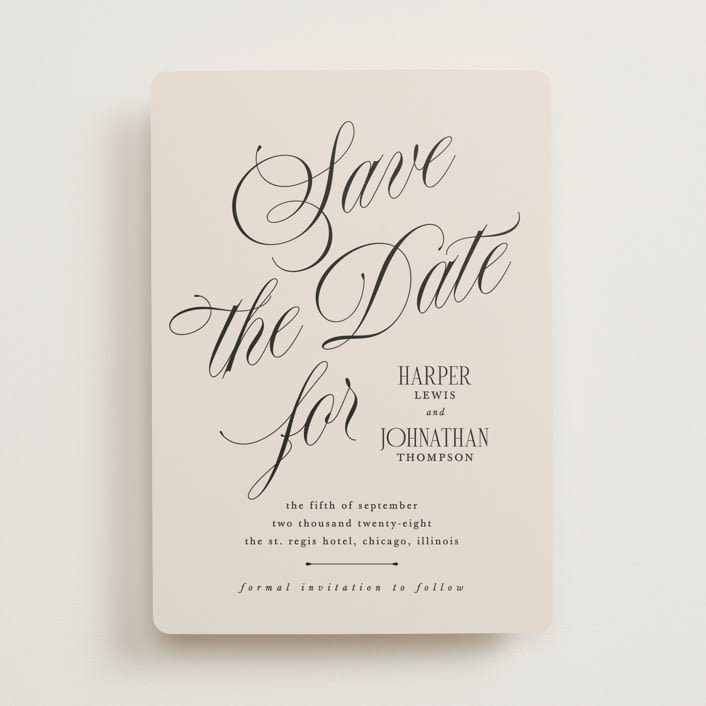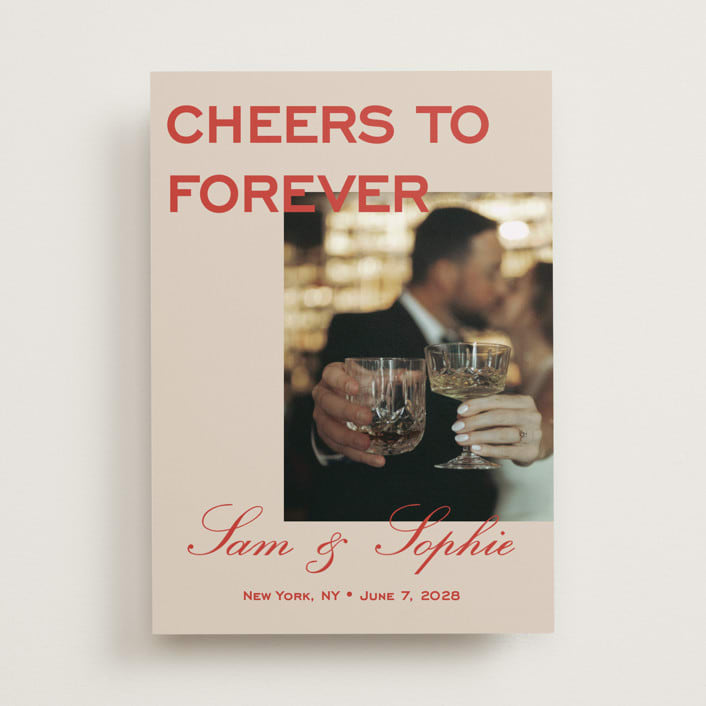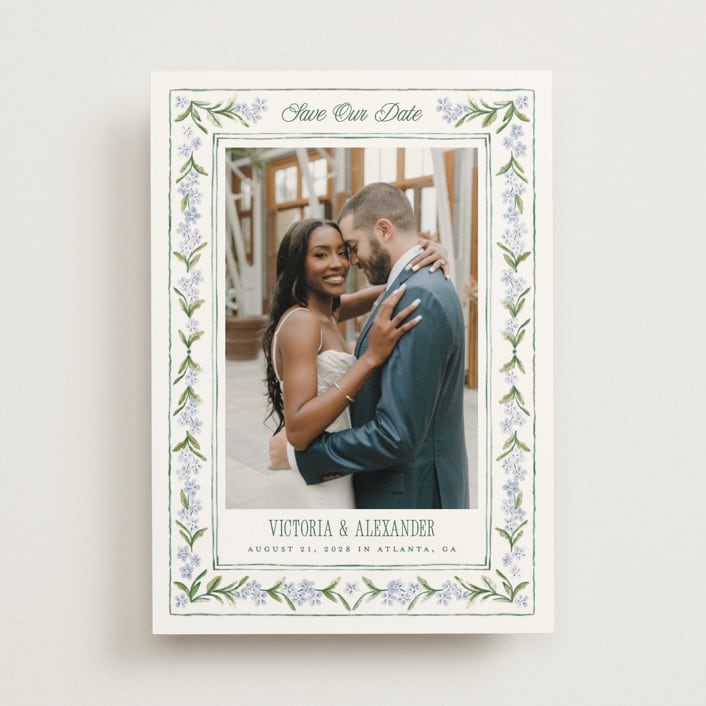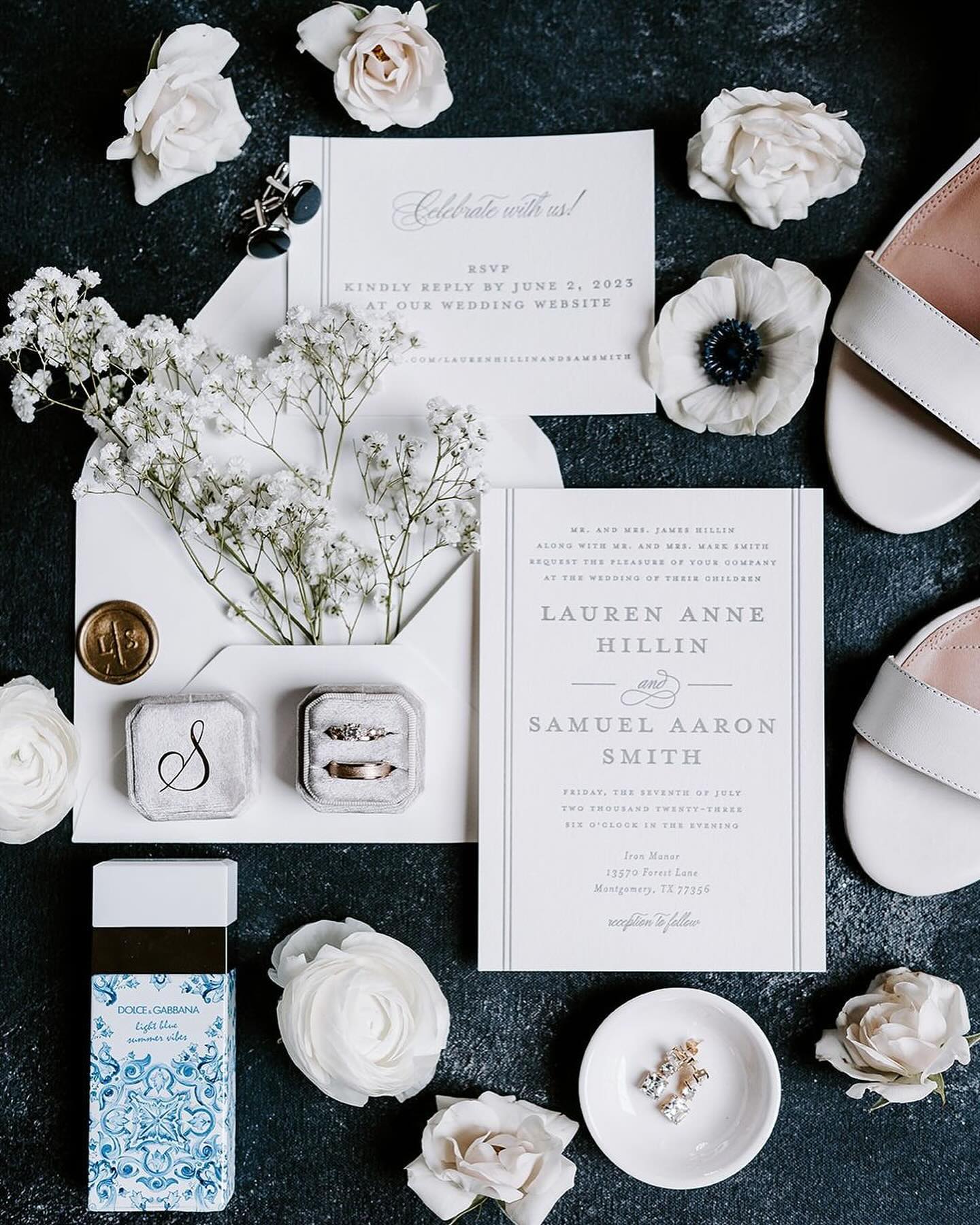Like so much of wedding planning, save the date cards seem simple until you start Googling. When should you send them? What exactly should they say? And what if you make a mistake that throws off your timeline or confuses your guests?
In this guide, the wedding stationery experts at Minted share the most common save the date mistakes ( and, of course, how to avoid them), plus expert advice on timing, etiquette, design, and must-have details — so you can make your first impression a great one.
5 Common save the date mistakes to avoid
Even with the best intentions, it’s easy to overlook small details that make a big difference. Here are five of the most common save the date missteps — and how to avoid them so your cards arrive polished, precise, and perfectly timed.
1. Sending save the dates too late
We’ll get into the specifics of when exactly you should send your save the dates a little bit later in this article, but know this: Timing matters. Sending your save the dates too close to your wedding date can leave guests scrambling to book travel or take time off work, especially during busy seasons or for destination events.
2. Including incorrect or incomplete information
This one’s a heartbreaker: typos, wrong URLs, or missing names can lead to confusion — or worse, a reprint. Always triple-check names, wedding dates, and your website URL. Ask someone who hasn’t seen the card before to proofread with fresh eyes.
3. Sending them to people not on the final guest list
Once a save the date is sent, the recipient is officially on your guest list. Sending them out before finalizing that list can result in uncomfortable conversations later if you have to scale back your invite count. Lock in your guest list first, then send.
4. Not including a return address or RSVP details (if applicable)
While RSVP info usually goes on your formal invitation, some couples include early RSVP options, especially for destination weddings. If you’re asking for any kind of reply, even informal, include a return address or contact info. Also, always include your return address on envelopes so you can keep track of any save the dates that didn’t make it to their final destination.
5. Using a design that doesn’t match the wedding tone
A playful, hand-drawn design is fun, but it may confuse guests if they later receive a black-tie invitation. Make sure the look and feel of your save the date reflects the tone of your event. Think of it as your wedding’s first impression: stylish, cohesive, and intentional.
When to send save the dates
Save the dates aren’t just a formality — they’re your first chance to get on your guests’ calendars and set the tone for your celebration. The standard recommendation? Send them 6 to 9 months before your wedding day. But with longer planning timelines and more destination weddings on the rise, many couples now opt to send theirs 9 to 12 months in advance of their big day.
That said, don’t send your save the dates before you have these essentials locked in first:
- Wedding date: This one’s non-negotiable. Your wedding date is the anchor for everything else. If it’s not finalized, hold off.
- Venue: Your venue typically determines your date, so these details usually come together. While including your exact location is tempting, we suggest keeping it simple and only listing the city, state, and country (if you’re headed abroad to say “I do”) on your save the date.
- Vibe: Save the dates are your guests’ first peek into what kind of wedding you’re planning — formal, playful, non-traditional, or entirely your own. Settle on your wedding vision before you send out save the dates so you can choose a design that reflects your vibe.
- Engagement photos: Most couples go with a photo save the date, so you’ll want a high-quality image ready to go. When booking or taking engagement photos, keep your wedding’s vibe in mind — your photo should feel like part of the overall story.
- Guest list: You don’t need every RSVP finalized, but your list should be nearly done before you order. This ensures you purchase the correct quantity and avoid the awkward mistake of sending a card to someone you may later uninvite.
When to send save the dates for destination weddings
If you’re planning a destination wedding, send your save the dates 9 to 12 months in advance. Travel takes time to coordinate, and early notice helps guests request time off, book flights, arrange childcare, and secure accommodations — especially during peak travel seasons.
When to send save the dates for local weddings
For local weddings — where most of your guests live nearby — you can send save the dates a bit closer to the big day. Aim for 6 to 9 months out. That gives guests plenty of time to block off the date and start looking forward to it.
When to send save the dates for micro weddings
Micro weddings (typically fewer than 50 guests) are a few cases where you might skip a formal save the date — especially if most of your guests already know the plan. That said, we still recommend sending invitations earlier than usual — around 4 months in advance — to give your inner circle time to prepare. If you do opt to send save the dates, we recommend sending them six to nine months in advance, as you would for weddings of more traditional size.
Pro tips for designing the perfect save the dates
Your save the date sets visually and emotionally expectations for your celebration. Every element plays a role in communicating formality, vibe, and personality. Here's how to get it right:
Photo Choice
If you’re using a photo-based design, choose an image that captures the spirit of your wedding. A black-tie event might call for a formal engagement photo, while a beach wedding could be paired with a relaxed, candid shot. The right photo does more than showcase your faces — it offers a glimpse into what guests can expect.
Typography
Font style can drastically shift the tone of your design. Serif or script fonts feel elegant and traditional, while sans-serif fonts give off a clean, modern vibe. Playful hand-drawn lettering can add a personal touch for more casual celebrations. Choose a style that reflects how formal or laid-back your event will be.
Cardstock
The weight and finish of your paper add a tactile layer to the first impression. Thicker, double-sided, or recycled cotton cardstock signals sophistication and quality. Specialty finishes like letterpress or foil stamping can further elevate your save the date and set the tone for what’s to come.
Creating a cohesive stationery suite
Consistency builds trust and anticipation. Think of your save the date as the first piece of a cohesive visual story. Use similar colors, typography, and motifs, including invitations, RSVP cards, and day-of signage, across your wedding website. Not only will everything feel beautifully connected, but your guests will also experience a smoother, more thoughtful journey from first invite to final dance.
Take the guesswork out of defining your wedding style by taking Minted’s Wedding Style Quiz. In just a few minutes, you’ll get a curated list of designs that match your taste and tone, making it even easier to find a save the date that feels like you.
Save the date wording: What to include
The practical purpose of saving the date is to give your guests plenty of advance notice as to when your wedding will be, increasing the chances they can attend. But save the dates do more than just inform — they also set the tone for your celebration in how they look and are worded. Here’s everything your card should include to do both effectively:
1. The date
Yes, it may seem obvious — but the most important job of your save the date is to share your wedding date. Choose a design that features it prominently, and make sure it’s legible. Avoid overly decorative fonts or background images that make the date hard to read.
2. Your names
It’s surprisingly common for couples to forget to include their names or to only use first names in a way that could confuse guests. First names may be enough if your design centers around a photo of you and your spouse-to-be. But for non-photo or more formal cards — especially if you have common names or large extended networks — include first and last names to avoid ambiguity.
When listing your names, tradition places the bride’s name first. There’s no rule for same-sex couples — choose the order that looks or feels best to you. If you prefer to keep the card minimal, you can include full names in the return address info printed on your envelopes.
3. The wedding location
Unless your venue is 100% confirmed and under contract, don’t list it. It’s better to include just the city and state (e.g., San Francisco, CA, or Kansas City, MO). Specifics like the venue name or address can be shared on your wedding invite or wedding website once confirmed.
4. Your wedding website
Your guests will have questions — lots of them. Including your wedding website URL gives them a place to find details like hotel recommendations, registry links, local attractions, and dress code. Even if your site is still in progress, you can note that additional information will be shared soon.
Pro Tip: If you're customizing a Minted wedding website, make sure it reflects the look and tone of your save the date for a cohesive experience. For help getting started, check out Minted’s guide to building a wedding website.
5. Save the date message
This is your chance to show a little personality — and give your card an emotional tone beyond the basic facts. Depending on your wedding style, you can keep it classic, or go playful, editorial, or romantic.
Here are a few message examples organized by tone:
Minimalist:
Save the date
Olivia & Eli
September 14, 2027
Invitation to follow
Romantic:
Join us for the beginning of forever
Leila & Jonah
May 3, 2026
New York, NY
Modern:
We’re getting married!
Avery & Blake
Los Angeles, CA
08.08.26
Formal:
Jeanine Raymond and Jacob Carter
Are Getting Married in Napa Valley
May 5, 2027
Formal Invitation to Follow
Playful:
We’re (finally!) tying the knot
Phoebe Neuman and Cyrus Mann
July 15, 2026
Energetic:
Pop the Champagne!
Savannah Baker and Nicolas Maleki
October 25, 2026
How to address save the date cards
Your save the date is the first piece of mail your guests will receive related to your wedding, and the way you address it says more than you might think. It not only sets the tone for your event but also gives clarity about exactly who’s invited.
For example, including “and guest” lets a single recipient know they can bring a plus one. Using full names versus nicknames, formal titles versus first names — it all matters.
While our comprehensive guide covers every address scenario in detail, here are a few go-to formats for the most common guest list situations:
- Single guest, no plus one: Use first and last name only
Example: Ms. Jordan Alvarez - Single guest, with a plus one: Add “and guest” after the name
Example: Mr. David Chang and Guest - Married couple: For formal weddings, include titles and last names. For more casual events, use first names.
Formal: Mr. and Mrs. Michael Chen
Casual: Michael and Emily Chen
Pro Tip: Use this option when addressing couples with children you’re not inviting — it subtly signals the invite is for adults only. - Unmarried couple: List both full names on separate lines or the same line.
Example: Jamie Rivers and Taylor Brooks - Family with children invited: Use the family’s last name or list everyone by name for a personal touch.
Example: The Bennett Family
Or: Sarah, Mark, and Ella Bennett
Thoughtful addressing adds polish to your cards — and avoids confusion later on. When in doubt, check your guest list, confirm how people prefer to be addressed, and refer to our Envelope Addressing 101 guide for trickier cases.
Digital save the dates
While traditional printed cards are a timeless favorite, digital save the dates are becoming an increasingly popular option, especially for couples planning on a shorter timeline, with sustainability in mind, or working within a specific budget. Here’s what to consider if you’re exploring the digital route.
When are digital save the dates appropriate?
Digital save-the-dates are a smart choice when planning a wedding quickly, if you’re working with an extremely small budget, or know your guest list is comfortable with email-based communication. They're also great for casual weddings, second weddings, or elopement-style celebrations where formality isn’t a top priority.
If you're planning a black-tie event or have older guests who may not check email frequently, printed save the dates may be the more considerate option.
Digital save the date etiquette
Sending your save the dates digitally still requires thoughtful presentation. Here’s how to get it right:
- Gathering email addresses: Ensure you have accurate, up-to-date email addresses for every household. Group emails (like a shared inbox between partners) work well — just double-check that you’re using the inbox your guests monitor.
- Tone and format based on formality: Digital doesn’t mean informal by default. Match your tone to your wedding style. Hosting a backyard brunch wedding? Go light and playful. Planning a more formal event? Stick with elegant fonts and a polished message, just like you would on printed stationery.
- When to send printed invitations later: Digital save the dates don’t replace formal printed invitations. Plan to send your printed invites 6–8 weeks before the big day — even if your digital card included all the event details. Printed invites are still considered the official request to attend.
- Following up with guests: Watch for unopened emails or bounce-backs. If certain guests haven’t responded or acknowledged your save the date, follow up personally via text, call, or email. For guests who may not be digitally inclined, ask family to help confirm they’ve received the message.
Pros and cons of going digital
Pros:
- Cost-effective and budget-friendly
- No need to pay for postage or envelopes
- Immediate delivery and trackable
- Eco-conscious and paperless
Cons:
- Less tangible or sentimental than printed cards
- Higher risk of emails going to spam or being overlooked
- Some guests may miss the message entirely if they aren’t digitally inclined
Minted’s wedding website builder is the perfect complement to digital save the dates. Choose from beautifully designed templates that match your overall stationery suite, and share your love story, travel info, registry links, and more — all in one place.
What to do after sending save the dates
You’ve mailed out your save the dates — now what? While taking a breather is tempting, this is a key moment to keep your planning momentum going. Here are the next steps every couple should focus on once the first round of wedding communication is out:
Finalizing your wedding website
Your save the date likely included a link to your wedding website — now it’s time to ensure that site is fully updated and polished. Double-check that all travel information, accommodation details, registry links, and answers to common guest questions (like dress code or child attendance) are listed. A well-built website sets the tone and avoids endless guest DMs later.
Designing your invitations
With the date designs sent, it’s time to start creating your wedding invitations (our favorite part!). Keeping design continuity between your save the dates and invitation suite through color palette, font choices, or theme adds a layer of polish. It also helps reinforce the tone of your celebration. Invitations are typically sent 6–8 weeks before the wedding, but we always recommend starting the design process well in advance so you can avoid rushed decisions (and fees!).
Setting up or updating your registry
Many guests will visit your registry after receiving your save the date, especially if the card includes a link to your website. Make sure your registry is live, complete with a variety of price points and items. Consider consolidating them using a universal registry tool or linking them on your wedding site if you're using multiple registries.
Frequently asked questions about save the date cards
Planning your save the dates comes with many “Should we...?” moments. We’ve gathered the most common questions couples ask and answered them in one place.
Are save the dates necessary?
Yes, especially if you're hosting during a busy season, planning a destination wedding, or simply want to give guests ample notice. A save the date isn't just a heads-up — it's the first piece of your wedding story and helps ensure the people you care about most can be there.
What’s the difference between a save the date and an invitation?
A save the date announces your date and location and lets guests know they’re on the list. The formal invitation, sent closer to your wedding, includes full event details and RSVP instructions.
When to send save the dates?
Send save the dates 6-9 months before your wedding, or 9-12 months for destination weddings. For micro weddings (under 50 guests), you can skip save the dates and send invitations 4 months early instead.
Do I need to send save the dates to all my guests?
Only send them to people you’re sure you’ll invite. Once someone receives a save the date, they’re officially on your guest list.
Do I need to include “plus ones” on my save the dates?
If you've already confirmed who gets a plus one, include it. If you're still finalizing, waiting, and clarifying on the formal invitation, it's okay.
Can I send digital save the dates instead of printed ones?
Absolutely. Digital save the dates are a great option if you're short on time or working with a tighter budget. Follow up with a printed invitation later, and check that your guests’ email addresses are current and accurate.
What information should be included on a save the date?
At minimum: your names, wedding date, and the city or region where the wedding will occur. If your wedding website is live, include that too.
Is it okay to send save the dates before finalizing all wedding details?
Yes — but only if your date and city are firm. You don’t need to sort every detail out before sending it. The rest can be shared later on your website or in an invitation.
What if my wedding date or location changes after I send them?
Life happens. If your plans shift after save the dates go out, update your wedding website immediately and contact guests personally via phone, text, or email to avoid confusion. You can also include a printed update with your invitation.
Can I design my save the date to match my wedding website or invitations?
Absolutely — and we recommend it. Visual consistency across your save the dates, wedding website, and invitations creates a polished guest experience and sets a cohesive tone for your big day.
How formal should the wording be on a save the date?
Match the tone of your wedding. A black-tie event might call for full names and traditional phrasing. A backyard BBQ-style wedding? Keep it fun and relaxed. Either way, make sure the message is clear.
Make it official (and unforgettable)
Sending your save the dates is more than just checking off a box — it’s your first real moment to say, “This is happening!” Whether you go digital or printed, formal or fun, thoughtful save the dates help guests plan and get them excited for what’s ahead.
Ready to find your design? Explore Minted’s save the date collection or book a free consultation with one of our wedding experts to personalize every detail.



